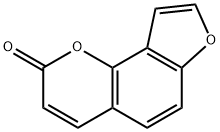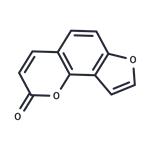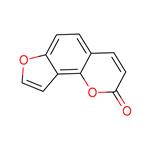Synthesis
Iodination of commercially available umbelliferone (7-hydroxycoumarin) yields 7-hydroxy-8-iodocoumarin. Acetoxy group can be introduced into hydroxyl of 7-hydroxy-8-iodocoumarin, which is used to create vaginol or vaginidiol with an isopropyl Grignard reagent and commercially available epoxy aldehydes. Subsequent acid-catalysed fragmentation of vaginol with dichloromethane in trifluoroacetic acid yields angelicin.
Toxicity
The LD50 of angelicin is 322 mg/kg which shows acute toxicity if orally administered to rats. The possible consequences are alteration in circadian rhythm and righting reflex, ataxia and analgesia.
Description
Angelicin is a furanocoumarin typically isolated from the seeds of
P. corylifolia. Like other furanocoumarins, angelicin has antibacterial activities against a number of Gram (+) and Gram (-) bacteria. It has also been shown to prevent tacrine-
induced cytotoxicity in human liver-derived HepG2 cells (EC50 = 47 μg/ml) and vascular relaxation in phenylephrine-precontracted rat aorta. Angelicin also weakly inhibits topoisomerase II (IC50 = 404 μM).
Chemical Properties
White Solid
Definition
ChEBI: Angelicin is a furanocoumarin.
Clinical Use
Angelicin derivatives are used to treat psoriasis and cancer. One way of treating these diseases is by photochemotherapy (PUVA) which combines UV irradiation with photosensitizing chemical. Also, it was shown that it is actively inhibits the synthesis of nucleic acids in tumor cells thereby decreasing their growth.




